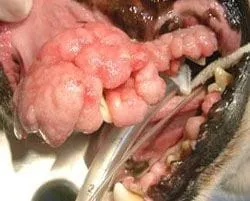The words “tumor” or “cancer” strike fear into pet owners and for good reason. Fortunately, the term tumor does not always mean a mass that will spread throughout the body. Tumor can mean a benign mass, that is one that does not spread to other parts of the body, or malignant, which means a mass that has the potential to spread to other areas. All tumors behave differently based on their type with some never spreading, some invading the tissues where they are, and some spreading out within the local tissues and spreading to other areas of the body.
Oral neoplasias (tumors) account for 6% of all tumors in dogs and 10% of all tumors in cats. Of these, 50% are malignant in dogs and 90% are malignant in cats. Many oral masses look alike, whether benign or malignant. The key to successful treatment planning is early detection and microscopic evaluation (biopsy) of all oral masses. Small lesions may seem insignificant due to their size, but if the mass turns out to be malignant, obtaining adequate surgical margins without major structural loss is much easier with lesions less than 1 cm than those larger. In most cases, complete surgical removal of oral tumors early in the course of disease is the preferred treatment. Dental radiographs can be a valuable diagnostic tool when evaluating oral masses.
Click here to read more about dental radiographs.
Generalities about oral tumors:
In general, benign tumors do not typically invade bone, as such, these lesions tend to deflect teeth and alter their position. On the other hand, malignant masses can be invasive into bone, and usually remove bone around tooth roots without displacing teeth. Notation of lymph node size and consistency along with chest x-rays, abdominal ultrasound, and other diagnostic modalities such as Computed Tomography (CT) or Magnetic Resonance Imaging (MRI) can also be helpful especially when staging oral tumors. Most benign lesions can be removed with small surgical margins extending into clinically healthy tissue only. The exception to this rule is the acanthomatous epulis (aka acanthomatous ameloblastoma, central odontogenic fibroma, adamantanoma). These tumors are technically benign because they have never been shown to spread to other organs, but they can invade into the bone surrounding teeth. These lesions involve the periodontal ligament of an affected tooth and successful treatment depends on removal of 0.5cm margins around the tooth/root involved, which usually results in the removal of the teeth on either side of the affected tooth. The acanthomatous epulis is also very sensitive to radiation therapy. Treatment with either radiation therapy or surgical removal with clean margins carries an excellent prognosis (95+%).
Malignant tumors require 1-2cm surgical margins into clinically and radiographically healthy tissue. The most common oral malignancies in dogs are the malignant melanoma, fibrosarcoma, and squamous cell carcinoma. By far and away, the squamous cell carcinoma is the most common oral malignancy in the cat. If caught early, many of these oral tumors can successfully be removed surgically. Those with higher potential to spread should have continued monitoring for early detection of other tumors. Regional lymph node aspirate prior to surgery or lymph node excision is advocated. Consultation with an oncologist with any malignancy is also recommended to consider all treatment options.
'The Pet Dentist' - Location, Map, Directions. Offices serving greater Tampa Bay, Clearwater, St Petersburg, Brandon & Bradenton :



